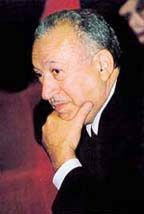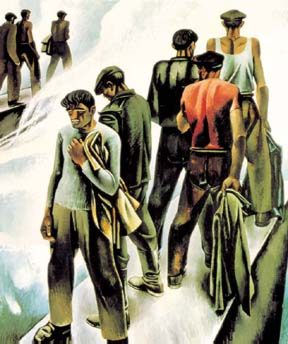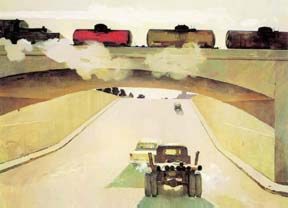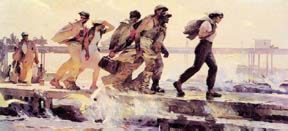|

Summer
1999 (7.2)
Page
51-54
Tahir Salahov
(1928-
)
A Hint of
Red - Pushing the Limits
of Socialist Realism
by Azad Sharifov and Jean Patterson
 Visit
AZgallery.org for more works of Tahir Salahov Visit
AZgallery.org for more works of Tahir Salahov
For Azerbaijani painter Tahir Salahov, red is a color that's
best used sparingly. It's great for accenting specific objects
- whether it be naturally red objects such as chili peppers,
pomegranates or books, or objects not normally associated with
red such as an oil tanker, an oil pipeline, a man's shirt, a
windmill or even the Eiffel Tower in Paris. In Tahir's early
work, apart from this touch of red, the remainder of his canvas
was typically spread with neutral tones ranging from light gray
and beige to darker shades of olive, brown and black. Take away
the red, which obviously was associated with Communism, and the
painting loses its dramatic edge.
Socialist Realism
Tahir's development as an artist starting out in the 1950s was
largely shaped by the Soviet government's mandate-namely, that
all artists should paint according to the style defined as "Socialist
Realism". Socialist Realism insisted that paintings should
mirror "real" life; that is, artists should "paint
what they see." Soviet authorities thought this would facilitate
the ability of the masses to comprehend art. In other words,
artists were not free to use symbolic representations. Colors
and shapes should be realistic. However, the term "Socialist
Realism" also implied that the subject matter that artists
painted would be cheerful, productive, confident and optimistic-not
gray, dismal, depressing or questioning.
But Tahir took this mandate a step further and created his own
style, thereby making his own statement. Today people refer to
it as "Severe Socialist Realism". Tahir's early works,
though realistic, dare to suggest that life was not rosy and
triumphant despite the fact that his themes clearly fell within
the prescribed formula.
  As a young painter,
Tahir Salahov knew all too well what could happen when one confronted
the Soviet system. When Tahir was only ten years old, his father
was arrested. At the time, his father was serving as First Secretary
of the Regional Party Committee in Lachin, a region in southern
Azerbaijan. As a young painter,
Tahir Salahov knew all too well what could happen when one confronted
the Soviet system. When Tahir was only ten years old, his father
was arrested. At the time, his father was serving as First Secretary
of the Regional Party Committee in Lachin, a region in southern
Azerbaijan.
Such scenarios
were repeated thousands of times during those horrendous years
of 1937-38 that became known as the years of Stalin's Repression.
Like a black widow that consumes its mate, Stalin and those under
his command eliminated any person of whom they were suspicious,
or in many cases, any person whom they held the slightest grudge
against.
The individual
had not necessarily committed a crime against the government
though, of course, stories were always fabricated elaborating
such crimes, and the individual was promptly branded as an "Enemy
of the People". Tahir's father was shot and killed on July
4, 1938.
Art: Tahir Salahov, "New Sea", 260 x 260 cm, oil
on canvas, 1970.
Tahir found refuge in the world of drawing - first, at the Pioneer
Palace and later in Art College. He remembers his first introduction
to art. He had borrowed a book from the library and after reading
it, someone suggested that he draw pictures to illustrate the
story. He kept the book several weeks longer and did just that,
and thus began what turned out to be a very successful career
in the arts. Later on he drew pictures for many books without
prodding from anyone. His first Exhibition was for the Belinski
Library in Baku.
At first, Tahir's family ties hindered his career. Once as a
first-year student at the Azim Azimzade Art Institute in Baku,
he took part in an Azerbaijan-wide contest of young painters.
Instead of using his own name, he submitted his work to the Commission
via two other artists who signed their names to it. The work
was awarded first prize. It took awhile before the identity of
Tahir as the real painter was learned.
Tahir's dream was to study at the Repin Institute of Fine Arts
in St. Petersburg. But he was not able to gain admittance to
the school, even though his skills were recognized by the Commission.
The issue of his father blocked his entrance. The son of an "Enemy
of the People" could not be enrolled. Determined to get
an education in art, he applied to Moscow to the Surikov State
Art Academy. This time he concealed information about his father
and was successful in gaining admission.
Severe Realism
  Tahir belonged to the
generation of young Soviet artists that emerged in the late 1950s
and early 1960s. Being from Baku, he often chose industrial Azerbaijan
as the subject for his early paintings. He loved the city, Ichari
Shahar (Inner City), the ancient Maiden's Tower, the Caspian
Sea and its sandy beaches. He loved watching the fishermen plying
their trade and the courageous workers coaxing the oil from the
earth's depths. Tahir belonged to the
generation of young Soviet artists that emerged in the late 1950s
and early 1960s. Being from Baku, he often chose industrial Azerbaijan
as the subject for his early paintings. He loved the city, Ichari
Shahar (Inner City), the ancient Maiden's Tower, the Caspian
Sea and its sandy beaches. He loved watching the fishermen plying
their trade and the courageous workers coaxing the oil from the
earth's depths.
In particular, the oil workers at Oil Rocks drew his attention.
Oil Rocks is a settlement built up like an island on wooden piers
out in one of the shallower sections of the Caspian Sea. It marks
mankind's first attempt to extract oil from under a major body
of water-not only in Azerbaijan but in the entire world. Oil
Rocks is nearly 50 years old now, but at the time it was quite
new, having been built only 10 to 15 years before Tahir began
focusing on it.
Art: Tahir Salahov, "Morning Train", 150 x 200 cm,
oil on canvas, 1958.
Today, oil workers still live in those dormitories and work in
that isolated, man-made environment. Set against this unsafe
environment of the treacherous seas, the oil workers became the
"heroes" in many of Tahir's paintings. They were strong
and hardworking-fitting symbols of Soviet industrial might. At
the time, the Soviet Union prided itself on its industrialization.
One memorable work is Tahir's "Morning Train" (1958)
which he painted a year after his graduation from the Surikov
State Art Academy in Moscow. His painting shows an industrialized
landscape in which almost everything visible is man-made. Cars
and trucks speed through a highway underpass while oil tanks
pass overhead. Most of the painting is made in neutral shades
of sand and cement, except for one oil tank car, which he painted
red. Visible exhaust coming out of the vehicles heightens the
sense of movement and reinforces the industrial motif. The painting,
with its dull colors and man-made modes of transportation framed
in concrete, lacks the usual warmth of human interaction. Perhaps,
that was part of what the artist was trying to say for those
who cared to understand what was not painted into the picture.
"Morning Train" was exhibited at the 1958 All-Union
Art Exhibition in Moscow, commemorating the 40th anniversary
of the Young Communist League.
Tahir went on to paint many more oil-related scenes over the
following years. Subjects in his paintings include a deserted
oil reservoir ("Reservoir Park", 1959), a group of
three oil maintenance workers on their way to an emergency ("The
Maintenance Men", 1960) and an up-close portrait of an oil
worker ("Oil Worker", 1959). Unlike the scenes found
in paintings following the style of Socialist Realism, Tahir's
workers are not romanticized. Instead, they look serious, tired
and dirty and often uncertain. The world he depicted on his canvases
was not the confident, optimistic microcosm that the Soviets
always tried to present to the world.
  Art: Tahir Salahov,
"The Shift is Over", 165 x 368 cm, oil on canvas, 1957. Art: Tahir Salahov,
"The Shift is Over", 165 x 368 cm, oil on canvas, 1957.
Another
example of Severe Socialist Realism can be found in Tahir's painting
"Women of Absheron" (1967). [See the back cover of
this issue.] A group of women stand near the shore, waiting for
their husbands-oil workers-to return home. One assumes that the
men live on Oil Rocks and only get a chance to come home occasionally.
Instead of talking
and mingling with one another, as would be expected of Azerbaijani
women, their eyes look vacant, somehow resigned to their fate
with the one exception of the oldest woman, whose eyes and face
are more expressive of the situation.
A sense of loneliness
is created by the fact that each woman is looking off into the
distance in a different direction. It's almost as if the women
are statues, islands unto themselves. With their sullen expressions,
they seem to be focused inward, unsure of the future, unsure
of their destinies-separated from their men and forced to carry
the responsibilities of their families on their own shoulders.
The painting does not show the women happy to be part of the
grand experiment of industrialization and production.
Again, Tahir uses red to accent his painting, this time in two
places: the clothing of the youngest girl and a piece of pipeline
which helps identify the narrative for why the women are gathered
together in the first place. The painting appeared in the 1967
All-Union Art Exhibition in Moscow; it is currently being kept
at Moscow's Tretyakov Gallery.
Tahir's travels abroad also influenced his style. He was one
of the privileged few who got a chance to visit countries such
as Czechoslovakia, France, Spain, Bulgaria, Italy, Mexico, Japan
and the United States and painted many of the scenes that he
saw there. In "The Mexican Bullfight" (1969), Tahir
recaptures a moment from his visit to Mexico. The frame is dominated
by a large, black bull facing off against a matador dressed in
bright red. A few sombreros in the background represent the excited
crowd in the arena. The focus is on the dramatic, ritualized
conflict against what appears as a faceless enemy.
Portraits
 Portraits
occupy a special place in Tahir's creative activity. He has painted
the portraits of Azerbaijan's foremost composers - Gara Garayev
(1918-1982) and Fikrat Amirov (1922-1984) along with Azerbaijani
poet Rasul Reza (1910-1981) and Russian composer Dmitri Shostakovich
(1906-1975), to name a few. Each portrait reflects Tahir's efforts
to draw out the inner worlds of his subjects. Portraits
occupy a special place in Tahir's creative activity. He has painted
the portraits of Azerbaijan's foremost composers - Gara Garayev
(1918-1982) and Fikrat Amirov (1922-1984) along with Azerbaijani
poet Rasul Reza (1910-1981) and Russian composer Dmitri Shostakovich
(1906-1975), to name a few. Each portrait reflects Tahir's efforts
to draw out the inner worlds of his subjects.
For example, Tahir's portrait of Garayev (1960) stresses the
composer's inner concentration and creativity. [This portrait
may be found in the article "Remembering Gara Garayev,"
AI 6.3, Autumn 1998]. Even though portraits were almost always
painted with the subject facing forward, Tahir established a
side view of Garayev. Once again, the colors are neutral tones,
except for a bright red music book. Garayev's face is plunged
in shadow, as if he has been caught in a moment of deep concentration.
At any moment, it looks like the composer might suddenly stand
up and rush over to the piano to jot down a few bars. This portrait
was awarded the Silver Medal of the USSR Academy of Arts.
Art: Tahir Salahov, "Portrait of the Russian Composer
Dmitri Shostakovich", 136 x 115 cm, oil on canvas, 1974-76.
When Tahir painted Russian composer Dmitri Shostakovich's portrait
(1974-76), he took a much different approach. Shostakovich, who
was seriously ill when he sat for the portrait, solemnly gazes
into space with his back to the piano. His frail hands rest on
a red velvet piano stool.
Today, Tahir Salahov lives in Moscow, where he is a professor
and has a studio at the Moscow Art Institute. He has received
numerous honors, including People's Artist of Azerbaijan (1962),
Secretary of the USSR Artists' Union (1968), Member of the Central
Committee of the Azerbaijan Communist Party (1970), Deputy to
the USSR Supreme Soviet (1970), Order of the Red Banner of Labor
(1971), President of the Artists' Union in Azerbaijan (1972),
People's Artist of the USSR (1973) Head of the Studio of Easel
Painting at the Surikov Art Institute in Moscow (beginning in
1974), Full Member of the Soviet Academy of Arts (1975), Order
of the October Revolution (1976), Grekov Gold Medal (1977), Deputy
to the Russian Supreme Soviet (1980) and numerous all-Soviet
and State Prizes for his paintings.
Tel: In Baku:
(994-12) 492-6267 (studio); (994-50) 317-6446 (mobile).
In Moscow: (95) 201-3971; Studio in Moscow: (95) 243-6551.
From
Azerbaijan
International
(7.2) Summer1999.
© Azerbaijan International 1999. All rights reserved.
Back to Index
AI 7.2 (Summer 99)
AI Home
| Magazine
Choice | Topics
| Store
| Contact
us
|

 Visit
AZgallery.org for more works of
Visit
AZgallery.org for more works of 


 Portraits
occupy a special place in Tahir's creative activity. He has painted
the portraits of Azerbaijan's foremost composers - Gara Garayev
(1918-1982) and Fikrat Amirov (1922-1984) along with Azerbaijani
poet Rasul Reza (1910-1981) and Russian composer Dmitri Shostakovich
(1906-1975), to name a few. Each portrait reflects Tahir's efforts
to draw out the inner worlds of his subjects.
Portraits
occupy a special place in Tahir's creative activity. He has painted
the portraits of Azerbaijan's foremost composers - Gara Garayev
(1918-1982) and Fikrat Amirov (1922-1984) along with Azerbaijani
poet Rasul Reza (1910-1981) and Russian composer Dmitri Shostakovich
(1906-1975), to name a few. Each portrait reflects Tahir's efforts
to draw out the inner worlds of his subjects.